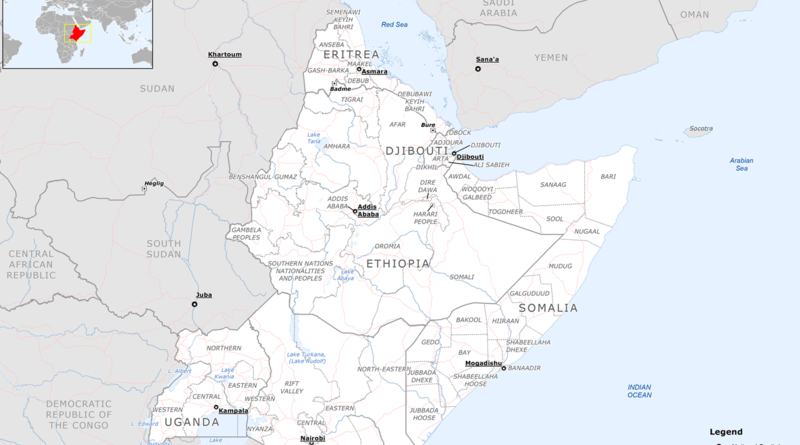The Horn Of Africa States: Why It Matters To The World – OpEd
The Red Sea, the Bab El Mandeb Straits, the Gulf of Aden, and the Somali Sea represent a major waterway that most powerful nations use and envy control of. This waterway is further complimented by another major feature of the region, namely the Blue Nile which provides most fresh water to northeast Africa.
The region also provides most meat to the Arabian Peninsula, especially during the Haj season, when millions of livestock are exported from the region on the hoof, for slaughter in one of Islam’s major rites. The long coast of the region stretches for some 4770 km from the southern Red Sea to Ras Kiamboni, the southern tip of Somalia on the Indian Ocean, and represents again a major potential blue economy, thus adding to the value of the region and its worth for the major regional and global powers of the world.
No wonder the BRICS expansion included five of the six members added to it consisting of countries that overlook the region. They include Ethiopia, Egypt, Saudi Arabia, UAE, and Iran. They are all marked by substantial wealth either currently exploited or potential wealth that may come forth in the not-too-distant future. The current wealth of the region and the five countries includes, among others, oil and gas, a large marketplace, and indeed, a substantial manufacturing base close to most markets of the world. The potential of the region also includes, as noted earlier a large blue economy consisting of priceless white beaches for international tourism, fishing, minerals including oil and gas, and other energy sources such as Eolic energy, solar power, geothermal, and hydropower, but most of all a third of uranium reserves in the world.
The region also owns substantial other resources such as vast cultivable lands, plenty of water, in the form of rain, rivers both seasonal and permanent, and lakes. It indeed owns native crops such as coffee, teff, enset, and others. It is a region blessed with other assets including a large youthful population, and substantial wildlife including large varieties of birds and other fauna and flora. The region exports most frankincense and incense to many markets including the Vatican.
With all these assets and resources in its varied climes and terrain encompassing some 1.9 mm square km, the region is, indeed, important for the world and the region’s leadership needs to harness this wealth for the sustainable development of the region in the place of seeking aid from NGOs and UN organizations who despite being present in the region over the past thirty odd years have not improved the lot of the region one iota. Indeed, their presence is reported by many as being the source of most conflicts in the region.
Since the region started to become closer together some years ago, there seems to have been opposition from parties interested in keeping the region conflicted and this has caused more afflictions mostly related to ethnic competition for power, which has not served the region well. Indeed, other trading blocks such as the EAC would seem to have been wooing some of the countries of the Horn of Africa States away from their natural allies to join the Swahili world. Somalia, which has erred before to have joined the Arab League to which it does not belong seems to be erring again to join another grouping with which it shares little. This affects the natural cohesion of the Horn of Africa States, which consist of the countries of the actual Horn of Africa States, namely Somalia, Ethiopia, Eritrea, and Djibouti, or the SEED countries as others put it. The four countries share similar populations, similar historical backgrounds, and traditional highland/lowland cooperation which dates to millennia.
The economy of the region is expected to grow as its population rises and investments are made by its substantial diaspora and others following them to the region. The need for a presence in the region is also expected to have major countries and middle-income countries take advantage of opportunities in the region in most economic activities across the full spectrum be it education, health services, manufacturing, trading, port services, and indeed tourism.
One area that should not be overlooked is the oncoming digital economies and technologies, where the youthful population of the region is expected to play significant roles. Note that Somalia’s economy is almost cashless, and as the years go by other countries of the region should be following this lead. The region’s substantial mineral resources include many required for new technologies such as copper, lithium, cobalt, and rare earths. The region also owns significant reserves of gold, uranium, platinum, and others. This should put the region at the forefront for investment considerations provided the region’s leadership is able to manage the tribal and ethnic conflicts of the region and the leaders are able to work together instead of with others first.
By working together, the region’s leaders would have common foreign, economic, trading, and political relations with other regions and countries of the world. This should make it easier for each country of the region to manage its space, economy, and people and hence assisting in the constitution of an inclusive sustainable development. This would no doubt eliminate or at least minimize the ethnic competition for power. The “it is my turn” ethnic-based power struggle would be removed from the political melodramas of the region.

